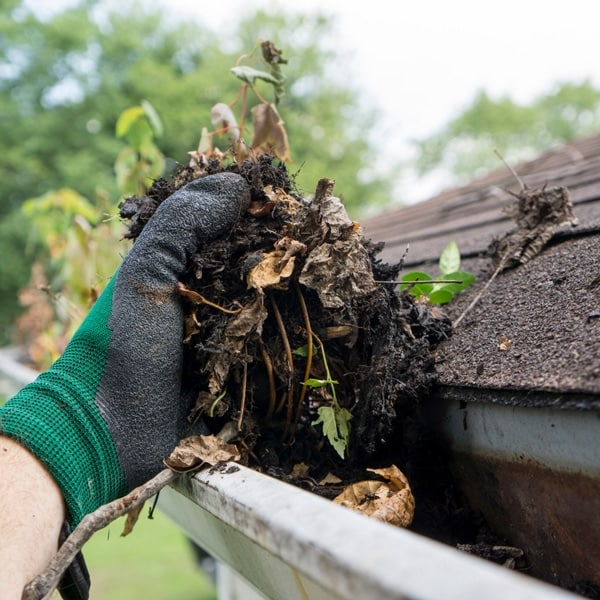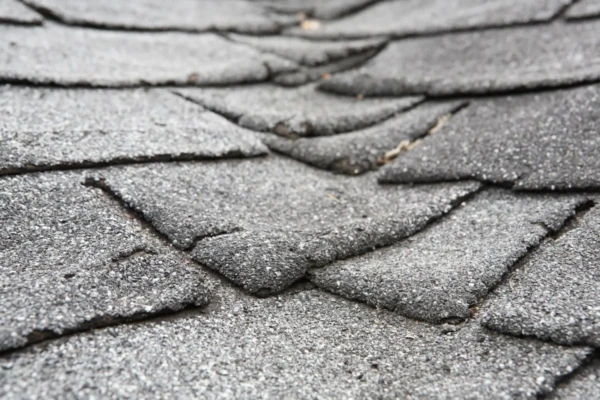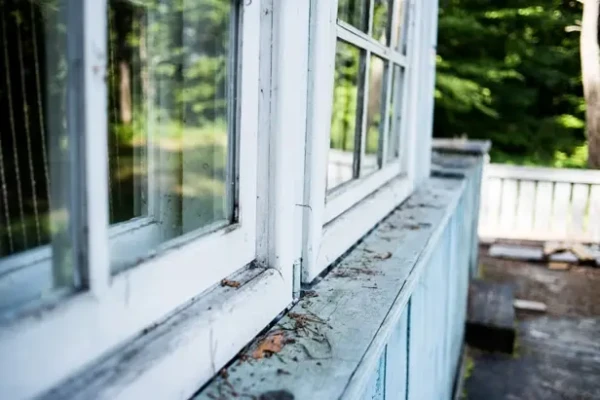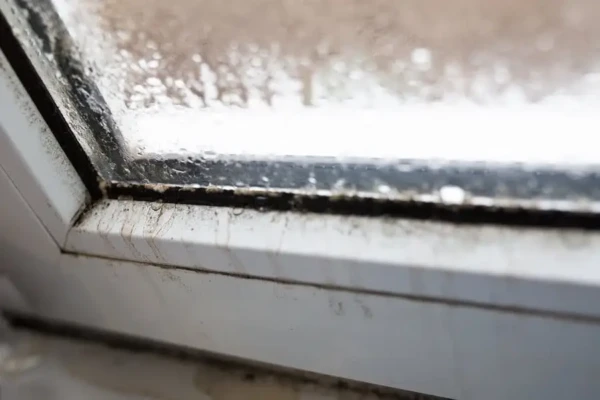Are you ready for spring home improvements?
We are! Get ready for summer with this simple 5 item checklist to get your home ready and prepared for the warm weather. Let’s Go!

1. Clean Your Gutters
Clearly (no pun intended) you need to clear those gutters of all debris including small twigs, dirt, and leaves. If you had ice dams this past winter they have the potential to damage your gutter, downspouts and/or your home’s exterior siding/fascia.
Make sure your gutter is intact and draining properly before you grab a hose to wash away dirt and leaves. Gutters should also not be sagging or broken.

The last thing you want is to create any leaks into your home. Gutter problems can cause serious issues and even more spring home improvements including foundational damage.
Spring Home Improvements: How to Clear Gutter Debris
- To really get your gutters clean and clear this season, you (or someone else) must climb up on the ladder so you can reach the gutter system
- Don’t be surprised if you find a lot of debris such as leaves, sticks, twigs, and even garbage that may have accessed your gutters via strong winds.
- Whatever you find in your gutter system, it must be removed to prevent clogs
- Be sure that you are wearing thick gloves if you plan to pull debris out by hand, otherwise, you risk getting poked with sharp objects in the gutters.
- Scoop the debris out and be sure that water can flow freely through the gutters and downspouts.
Common Gutter Problems
- Look for rust and loose nails
- Beware of sagging or broken areas of your gutters, potentially cause by ice dams
- Check for leaks around the joints
- Check around your home for foundational problems or pooling water
2. Check Your Roof for Damage
The winter season can do extensive damage to your home, such as damaged shingles and even rot on the roof deck. Check your roof shingles to see if there are any missing, curling, rotting, or loose. Loose shingles can allow moisture inside your attic space, resulting in expensive repairs.

Also, check for algae growth. On the inside of your home check for water spots on your ceiling as this can indicate leaking and roof trouble.
Why Worry About Your Old Roof?
The roof can undergo extensive damage from New England weather—especially if it’s poor quality, old, or missing shingles. If your roof isn’t performing properly, you can lose up to 25% of your home’s energy!
- Check for missing shingles. Missing shingles directly expose your home to the elements and result in many issues, ranging from energy loss to moisture damage.
- Check for damaged shingles around the gutters. This indicates that there was damage from ice dams, which can be heavy and strong enough to pull the gutters right off of your roof.
- Check for leaks. One of the common areas where roof leaks occur is around inadequate flashing as well as valleys. Flashing around the chimney plays a prominent role in preventing moisture problems. These leaks can lead to major structural damage in the roof and chimney if not addressed quickly.
- Look for stains on the rafter beams, discoloration, and mold or mildew. This further indicates that there is a leak that is coming from somewhere in the roof.
Replace leaky and faulty roofs with quality and energy-efficient roofing system. High-quality roofing such as our GAF products are designed to last a lifetime. Our professional roof installation keeps energy locked inside of your home while preventing leaks. This combats against mold and mildew, energy loss, and structural damage.
3. Check Your Home Siding
Are you ready for some serious curb appeal? Tired of peeling paint and faded siding, which only adds to your spring home maintenance checklist?

Before you liven up your home give your home a look over before you head into a fresh, spring makeover.
Why Worry About Old Exterior Siding?
Your siding is yet another exterior component that battles against New England weather. Damage to your siding can seriously impact overall home performance as well as your curb appeal.
- Check for discoloration in the siding along the eave edges. This is a telltale sign of moisture damage from ice dams.
- Look around and make sure all siding panels are straight and flush against the exterior. If the panels have popped out, moisture may have seeped behind while becoming a mold and mildew breeding ground.
- If panels are loose have fallen off, look closely for mold growth. You will also want to inspect for damage to the exterior walls caused by mold or wear from the harsh New England weather.
- If your panels are wood, take the same approach as for wood window frames to check for rot. Push a screwdriver into the siding and see if the screwdriver sinks into it. Other signs of failing wood exterior include bucking, warping, and peeling paint.
Replace underperforming siding with quality vinyl siding. It protects your home from rain and wind, especially since 60% of homes are vulnerable to wind damage from storms.
Choose quality vinyl siding or James Hardie siding that is professionally installed and protects your home from all elements.
Upgrades such as our Prodigy ComfortFactor can make your home cooler in the winter and warmer in the summer, featuring an exceptional R-value and industry-leading thermal barrier.
Also, you can have the look of wood shakes (very popular!) and have it be maintenance-free for life. Learn more about our maintenance-free vinyl siding.
Side Note: Please don’t power wash your siding before checking into your warranty as this could void it.
4. Check Your Windows
For your next task of spring home improvements, Be sure to check your windows and doors to ensure they are still functioning properly.
Many homeowners had ice dam leaks this winter and you’ll want to make sure your windows weren’t compromised. Your windows should NOT be drafty or have any air leakage.

Check the caulking and weather stripping around your windows and doors to ensure a tight seal as this is your first line of defense against air and water. If you see any condensation on your windows (fogged glass) it means that your windows are no longer working properly. If you do need to replace your windows, don’t fret, energy-efficient replacement windows can offer a 72% return on investment!
Why Worry About Damaged Windows?
Rainy or snowy seasons bring a lot of moisture. One of the first steps to take is inspecting old windows for moisture damage, especially if your New England home has wood window frames. If the window becomes damaged by rain or snow, it means the window is no longer performing.

How to Detect Moisture Damage in Windows
- Look for discoloration around the windows and on the frames. On the interior of the home, you might find water spots and stains in a brown, yellow, or copper color.
- Walls may crack, bubble or paint can peel away from the surface.
- Wood window frames may display changes in texture. For example, wood window frames may buck when they become detached from the siding. You may also discover sagging window frames that feel spongy in comparison to new wood window frames.
- In the right conditions, mold and mildew growth can form on both the interior and exterior walls.
- With severe moisture damage, you can poke a wood window frame with a screwdriver and it will sink right through the frame.
Other maintenance window problems that need to be addressed include fogged glass that won’t wipe away, drafts around the window frames, and high energy bills.
Replace underperforming windows with quality vinyl replacement windows. Select windows that are certified by Energy Star which are proven to save over $400 per year in the New England region.
As for your front door, check for peeling paint and cracking. A cracking wood door could indicate water penetration. Replacement entry doors were found to offer the highest ROI of any home improvement! Find out the top ROI home improvements now.
5. Check Your Entry Door
Now that home remodeling season is in full swing, you might be wondering if you’re ready for entry door replacement. Today’s entry doors are built to last for decades, especially high-quality fiberglass doors. However, the first step is to recognize if your current door is in need of replacement.

Why Worry About Old Entry Doors?
Old entry doors are a cosmetic, performance, and security issue. Replacing your door can help reduce drafts and keep your family safe. Not to mention, it’s a quick way to create incredible curb appeal and check another item off your spring home maintenance checklist.
How to Detect Door Problems
- Give your door a look-over and see if you find signs of wood chipping or rot.
- Check if your door sticks within the frame. Varying humidity levels, much like we have here in New England can cause wood doors to expand and contract. Wood gains about 1% moisture for every 5% change in relative humidity. If your entry door is excessively sticking, it’s time to think about replacing it. This is an indicator that the door is aging or is possibly not fitting correctly within the frame.
- Check if you feel drafts around the door. When homeowners think about energy savings, don’t think about an entry door. If the door is old and the weatherstripping is worn down, it’s not unlikely that air is making its way through the top, bottom, or sides of the door.
- Notice if rainwater is coming through your door, as a drafty door may also be leaking rainwater. You’ll find rainwater leaking around areas such as the frames and even underneath the threshold. If the water is coming underneath the threshold, sometimes adjusting it can block out water.
Spring Home Maintenance Checklist: Upgrade Your Home for Spring with Coastal Windows & Exteriors
We make it easy to achieve exceptional curb appeal and increased home performance. You can also check our limited-time Spring Promotions! We’d love to hear what you are doing to prepare your home for the season and help with your replacement projects. Contact us today for a free quote!


